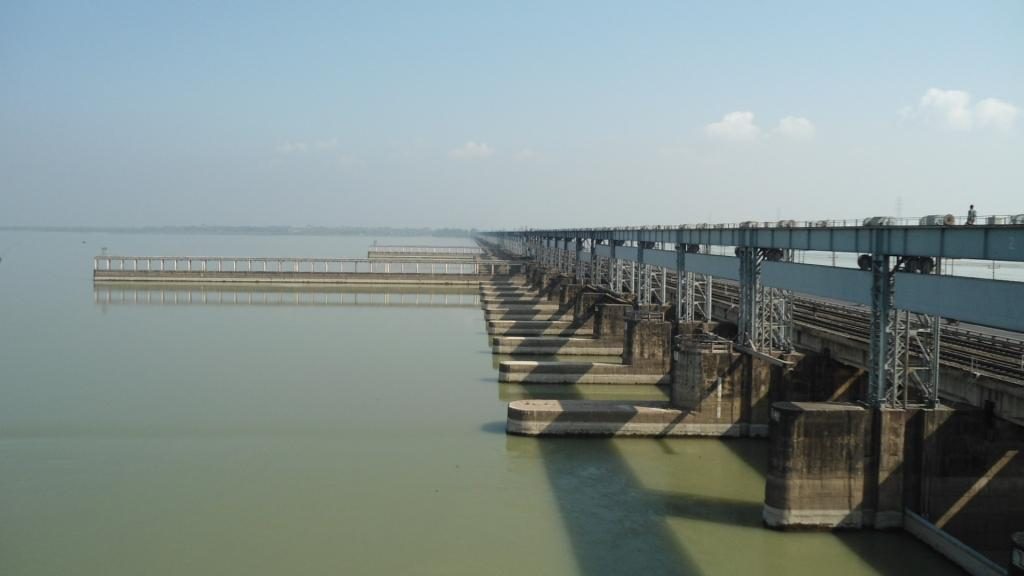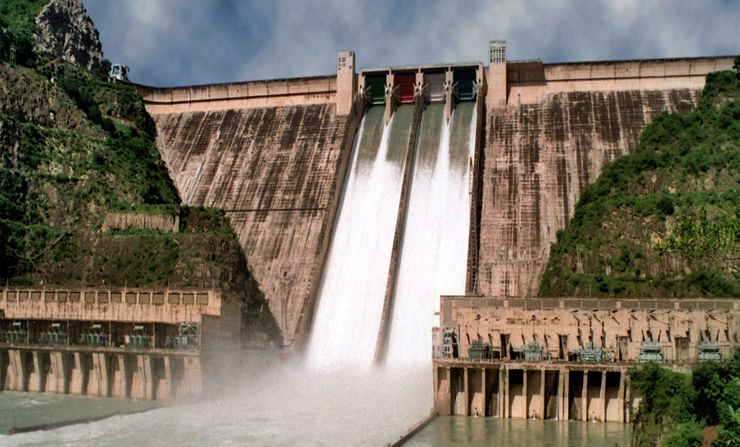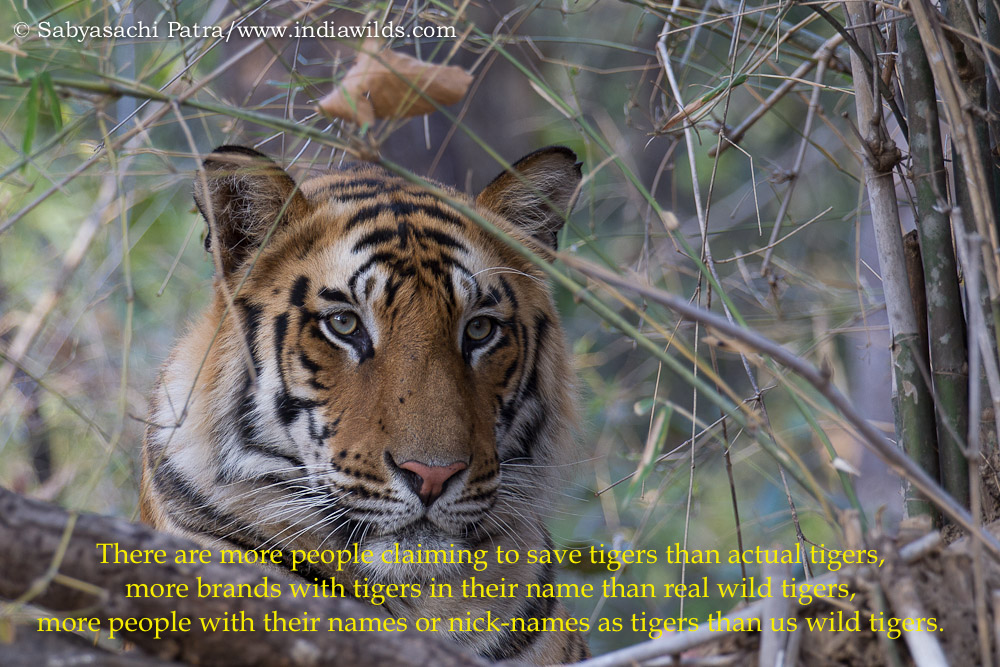IndiaWilds Newsletter Vol. 8 Issue VIII
 Role of Dam in Floods
Role of Dam in Floods
The Holy river Ganga is in flood. Ganga which is revered by millions of Hindus and is known as Ganges to the western world has swollen and its overflowing waters have reportedly affected 2.2 million people of Bihar in the past few days and 22 people have been officially dead. Normally, as soon as a state faces major floods, the Chief Minister makes demands for flood relief from the centre ranging from several hundred crores to thousand crores of rupees. However, this time in a very interesting intervention, the Chief Minister has not asked for monetary compensation.
The Chief Minister of Bihar, has brought the plight of the river Ganga to the forefront by saying that he feels like crying watching the condition of the mighty river. Terming these floods as a man-made disaster, he has highlighted how human intervention has resulted in inviting the fury of the river. Despite Bihar getting 14% less rainfall than normal, there is a flood like situation in 12 out of 39 districts of Bihar. According to the Disaster Management Department Patna, Vaishali, Buxar, Bhojpur, Saran, Begusarai, Samastipur, Lakhisarai, Khagaria, Munger, Bhagalpur, and Katihar districts are witnessing flood-like situation.
Nitish Kumar, CM of Bihar has rightly pointed the role of the Farakka dam in drowning Bihar and has said that “the main reason for the floods in Ganga is the excessive deposition of silt in the river due to the construction of the Farakka barrage. We need to reevaluate the need of the barrage”.

Farakka Barrage Image Courtesy – Online media
In 1954 Shri Jawaharlal Nehru, India’s first Prime Minister coined the term “Temples of Modern India” to describe large infrastructure projects and large dams constructed over rivers were also included in this description. During the first Five Year Plan, three large dams such as Bhakra-Nangal dam, Hirakud dam and Nagarjuna Sagar dam were constructed. However, soon thereafter looking at the devastation caused by the dams on the lives of the displaced people, Nehru had changed his views and in 1958 had talked about promoting small irrigation projects. Unfortunately, the Government of India continues to believe in mega structures like these dams.

Bhakra Nangal Dam Image Courtesy – Online media
Sixty two years after Nehru coined the term Temples of Modern India, and 58 years after he talked about promoting smaller dams, a Chief Minister for the first time has made a scientific argument against dams. So it is a very interesting moment for India.
Scientific studies has shown that the dams have lost their efficacy because there is too much of siltation which reduces the carrying capacity of the dams. The siltation results in the river meandering and creating new loops to contain the water stopped from flowing by the dam. This results in new areas coming under water.
Apart from the Resettlement and Rehabilitation problems caused by dams, there are plenty of problems for downstream victims of dams.
Fisheries in large resorvoirs of dams are 2-3 times less productive as compared to riverine fisheries (Jackson and Marmulla, 2000).
Farmers in the pre-dam era used to practice cultivation based on their knowledge of flooding patterns of the river and raised crops that could benefit from the flooding. Unfortunately after construction of dams, the farmer know longer could predict the time and extent of flooding and their historical knowledge was wiped out in one stroke rendering them a massive dis-advantage. There has never been systematic and large scale surveys to understand the complete impact of dams on the people living downstream as it is not simply possible to undertake such a massive exercise. Accordingly our knowledge of the deleterious impact of dams is very less and the Government has never been able to take it into consideration for constructing dams.
Farmers knew that the floods carried silt which helped them in their agriculture. Unfortunately, with the construction of the dams, the silt got deposited in the dams and became the bane of the dams as their carrying capacity got reduced. With man waging a relentless war on forests resulting in all the forests in the catchment area of the rivers getting denuded, the rivers increasingly carry the top soil which is good for agriculture but also much more mud and pebbles and other sediments which are not suitable for agriculture and which result in filling up of the dams at a much faster rate than anyone would have ever imagined while planning the dams.
Though the CM of Bihar has requested the Prime Minister of India to help remove the silt from the river induced by the Farakka Barrage – as the large scale deposition of sediments has raised the level of the river bed resulting in more flooding – unfortunately, simply dredging of river bed would not suffice. The forests bordering the rivers have to be mandatorily protected and regenerated. Planting native vegetation all along the river banks and cordoning off areas to allow regeneration of native vegetation will help. For this river floodplains as well as the adjoining areas have to be simply declared as No-Go areas for construction and development. These have to be maintained as natural flood plains and forests. The way encroachments are removed from landslide prone areas, similarly, existing encroachments in the areas bordering the rivers need to be declared as belonging to the riverine ecosystem and protected by law.
Dams, like Farakka, have outlived their utility and need to be urgently done away with and the river be allowed to flow, as it once used to, without any hindrance. Whereas the Bihar Chief Minister has taken the help of experts to make a pitch against the Farakka Dam and the Prime Minister is expected to get scientific opinion before deciding on the future course of action, the RJD leader Mr. Lalu Prasad Yadav’s comment to the flood affected victims that they should feel fortunate that “Ganga maiya” (Mother Ganga) has come to their house has invited condemnation and succeeded in trivialising this issue.
The river Ganga is indeed revered as mother and people believe taking bath in its waters absolves them of their sins. For centuries people have depended on the waters of this river for their religious rituals. So it is a dichotomy that successive Governments have lent their hand to throttle the river and reduce it to a trickle in many places. This is a first time when a demand to reverse these actions have come from the Head of a State.
Unfortunately, during disasters the Governments are known to ask for constitution of expert committee to study the problem and by the time the report comes, the Prime Minister would have completely forgotten the issue and the report shelved by the officials. Will it also happen this time and the case against Farakka dam allowed to gather dust?
If the Narendra Modi Government can do a rethinking of Dams, then history will judge him favourably.
Celebrating the Tiger
Tiger has captured our imagination since time immemorial. Its power, intelligence, regal looks and aura has been told and retold through many a stories, songs, myths, ballads and movies. The fate of the tiger has become intrinsically linked with humans, albeit in an inversely proportional manner. With the rise in human population, the forests have been cleared for man’s need as well as greed. With the fall of the forests, the tiger first slowly retreated from many of its former range and then has started its fast spring towards extinction.
Realising the need to protect the tiger, one day in the calendar has been declared as International Tiger Day. Just like valentines day, fathers day, mothers day etc were supposed to be created by a company to sell more greeting cards, the International Tiger Day seems to be travelling in similar directions.
Whereas a host of NGOs brag about the increase in tiger numbers using questionable statistics for bagging a few dollars more from their donors, the public at large believe that all is well with the tiger and join the game of celebrations.
A cursory look at the number of tweets on International Tiger Day and their contents, one can find that anything and everything is discussed starting from Wild Tiger rum, Tiger Beer, Tiger air, Detroit Tigers, an Unix security tool called Tiger as well as an emerging Bollywood hero called “Tiger Shroff” and many more.
There are many brands that have tiger in their names than actual number of wild tigers. So despite celebrating International Tiger Day with all our tiger photos and videos, the fate of tiger doesn’t change a bit.
There are many species in the world, which doesn’t adhere to our conventional sense of beauty and are not one of our favourites. It would be understandable to find difficulty in drumming up support for preserving species which fail to capture the imagination of people. However, tiger is not one of those least known species. Chances are there would not be a single child who doesn’t know what a tiger looks like. Despite being a charismatic species, the tiger faces insurmountable odds in its survival.
People throng to the few premier national parks where it is relatively easy to sight tigers as compared to other sanctuaries and national parks. In places like Ranthambhore, one of the tigress which was easily sighted was given the name of “Machli” and was highly photographed. Looking at the popularity, some tour operators even created and bestowed a life-time achievement award on the tigress Machli. Fortunately no one thought of hanging the medal on the neck of the tigress.
The tigress Machli may at some time in her life would have wondered why she is being given live baits by the forest department. Despite losing her canines and being failing eyesight, she survived for 19 years. A forest guard was even posted to keep watch on the whereabouts of the tiger. There were many sad faces when the news of the death of Machli flashed across newspapers. Looking at the many people talking about her and the whatsApp messages, an alien would have mistaken that as a strong intent for tiger conservation. Unfortunately, it is not.
The prey base in the forests adjoining Ranthambhore is low as is the level of protection of the habitat. Anthropogenic disturbances doesn’t help a species like the tiger. Tigers have frequently wandered far away from Ranthambhore tiger reserve in search of a suitable territory. The Rajasthan Government is also known to have set up camera traps in Kuno-Palpur Wildlife Sanctuary where the tigers from ranthambhore have been found to have travelled to disperse despite lack of contiguity and the long distance. In the past a male tiger was also known to have traversed through sugarcane fields and other cultivated land and reach Keoladeo Ghana National Park. There it had a steady supply of feral cattle to prey upon apart from the few Nilgais, Sambars and spotted deers. Unfortunately, before it could significantly reduce the feral cattle population of Keoladeo Ghana it was captured and relocated to Sultanpur Tiger Reserve.
Love and protection for one tiger doesn’t translate to an entire species.
We need to move beyond individual tigers to saving the tigers as a species. If we have to save the tigers, then we have to first save their habitat.
Tigers cannot thrive in disturbed landscapes: We have to ensure that there are sufficient inviolate spaces for tigers to breed and survive. We need to recreate contiguous forests to reconnect our tiger landscapes. This will ensure that tigers can freely move from one forest to another to establish their territory and replenish the habitat vacated by other tigers. We need to ensure that there is adequate protection for tigers and their prey in these landscapes.
Penalties in Wildlife Crime: India for a long time had very low level of penalties associated with wildlife crime. If the draft WPA as is being discussed in the ministry is to be believed then this seems to be changing. If a person is caught selling meat of a species in Schedule I or part II of Schedule II then the punishment is imprisonment for a minimum of five years and it can go up to seven years. Along with imprisonment there will be a fine of at least one lakh rupees and in special cases it can be extended upto 25 lakh rupees. The second or subsequent offence will lead to minimum 7 years imprisonment and upto fifty lakh rupees fine.
Where the offence relates to the sale or purchase or transfer or offer for sale or
trade of any animal specified in ScheduleI or partII of ScheduleII or the meat of such
animal or animal article, trophy, or uncured trophy derived from such animal or any
violation of ChapterVA, shall be punishable with imprisonment for a term which shall not be less than seven years and also with fine which shall not be less than fifteen lakh rupees.
The increase in severity of the penalties can act as a deterrent if at all the perpetrators and the likely perpetrators get to know about it. Unfortunately, the dissemination of the provisions of the law is not wide enough. There is also the added challenge of low conviction rate in wildlife crimes as many cases fail in the prosecution stage due to lax collection of data and the loopholes are not plugged.
Though the Government often talks about working to protect the tigers and wildlife, the rate at which our forests are sacrificed for large projects, mines, dams, canals and other uses, it is hard to believe that the tigers can thrive in the wild for long. In fact, the National Board for Wildlife (NBWL) which is chaired by the Prime Minister has yet to have a single sitting under the current dispensation. Nevertheless, India’s Environment Minister has urged foreigners to visit Indian forests to watch the tiger.
We fervently hope that that the tiger has more survival skills to save itself before we get our actions together to make meaningful interventions to save our wilderness and wildlife.
Conservation News
India’s Env. & Forest Minister urges Tourists to visit India for Tiger Watching
In an event to commemorate the International Tiger Day, India’s new Minister for MoEF&CC Shri Anil Madhav Dave urged tourists to visit India for watching tigers. He expressed hope that India will double the tiger numbers. Unfortunately, he never talked about the systematic decimation of forests in the tiger landscape in the name of development.
The Environment Minister said that the Tigers are spread out in over 17 States and 49 sanctuaries across the country. He stated that a healthy Tiger is a symbol of healthy environment. He said that people in India love the Tiger and are conserving it and that India has 2226 tigers which constitutes 70% of the population of the tiger world over. Unfortunately, the science or the lack of it, in estimating tiger numbers in India as well as in the world has been much talked about earlier. Nevertheless, people who want to tell us that all is well with the tiger ie the Government, NGOs who want to raise funds in the name of tiger, tour agents etc continue to talk about this number. Because of this the message that goes out is all is well with the tiger.
The minister also said that “due to the ongoing conservation efforts under Project Tiger, India has the maximum number of tigers, along with its source areas, amongst the 13 Tiger Range Countries in the world. The status of wild tiger across Tiger Range Countries (TRCs) continues to remain endangered. Though there have been some gains in the population build-up in some TRCs like India, Nepal, Bhutan and Russia, the global scenario is a major cause for concern. Tigers have become locally extinct in some TRCs and the status of prey, as well as the habitat, has declined in many. The heads of Governments of Tiger Range countries which inter alia includes India, have resolved to strive to double the number of wild tigers (T X 2) across their range by 2022 and adopted the St. Petersburg Resolution on Tiger Conservation, at St Petersburg, Russia, wherein July 29 was endorsed as Global Tiger Day”.
There have been enough noise in the social media about the tiger day, but the tiger is oblivious to all this and is leading a precarious existence. Nevertheless, it is welcome that the Ministry along with its conservation partners want us to take a pledge for Tiger conservation. Following is the pledge:
Pledge for Tiger conservation
I recognize and value,
That tiger is an umbrella species with charisma, and is the flagship indicator of a balanced ecosystem;
That a balanced ecosystem is crucial for life support, while providing numerous ecological services to the society;
Being aware that the status of wild tiger is highly endangered in its natural habitat across Tiger Range Countries with a declining global population;
I hereby solemnly pledge:
To protect the tiger and its wild habitat to ensure crucial ecological services for posterity;
To contribute for fostering awareness for tiger conservation by factoring in its concern in areas where tiger is not the goal;
To work for a balance between tiger conservation and ecologically sustainable development towards harmonious co-occurrence of human beings and the tiger;
Commit to conserve our natural heritage while making all efforts for the future sustenance of wild tiger.
We hope that the MoEF&CC takes this pledge seriously and doesn’t act like a project clearing agency but focuses on its job of protecting India’s wilderness areas and wildlife.
Lion Translocation in Limbo
It is interesting that after a long time the issue of lion translocation was discussed in the lok sabha. Jyotiraditya Schindia, the Member of Parliament from Guna, Madhya Pradesh raised a question and strongly pitched for relocation of lions to Kuno-Palpur sanctuary in Madhya Pradesh. https://www.youtube.com/watch?v=X9Ui5n0W-Cg
In his question, Mr. Scindia mentioned that Gujarat has got 523 lions as per the survey and in the recent floods in Bhavnagar and amreli 10 lions have died. He said that if a contagious disease attacks the lions then at one go all these lions can be decimated forever. He reminded the house that the current PM of India had stopped the translocation of lions from Gujarat to Kuno-Palpur Sanctuary in Madhya Pradesh on the pretext of “Gujarat asmita” or Gujarati pride. However lions are not only the pride of Gujarat but also the pride of India, so the Hon’ble Prime Minister Mr. Narendra Modi should relocated 40 lions to Kuno-Palpur. During his speech, Mr. Scindia also mentioned that sixty crores of rupees have already been spent in relocating 24 villages from Kuno-Palpur sanctuary and with 50 animals/square foot there is a sufficient prey base for the lions.
The Hon’ble Supreme Court of India had in its judgment (http://www.indiawilds.com/diary/indiawilds-newsletter-vol-5-issue-iv/) asked for relocation of lions. Unfortunately three years have passed but the Government hasn’t ensured relocation of lions to Kuno-palpur in Madhya Pradesh to create a second home for lions. On 21st August, Shri Anil Madhav Dave, MoS for Environment, Forests & Climate Change said that Lions will be relocated from Gir to Kuno-Palpur but he failed to give any definitive date.
The minister said that nearly 80% of the work on lion reintroduction to the Kuno-Palpur Sanctuary has been completed and the MoEF&CC is working on the reintroduction. He said “Two meetings have already been convened on the project. My aim is to translocate lions to MP and I am working on it. But I can’t give any time frame. Without much hype or taking credit for it, you will see lions arriving in the state someday.”
Unfortunately, all the work that the Minister is alluding to is done by the Madhya Pradesh Government. Neither the Gujarat Government has officially spoken that they will allow the lion translocation or the Prime Minister Shri Narendra Modi has made any statement about it. Since the virulent protest by the Gujarat Government against the lion translocation was with the tacit support of Mr. Narendra Modi, the then Chief Minister of Gujarat, there doesn’t seem to be much hope for translocation of lions to Kuno-Palpur Sanctuary in Madhya Pradesh in the near future unless the Government is strongly directed by the Hon’ble Supreme Court of India.
For more on survival challenges of Indian Lion check here: http://www.indiawilds.com/diary/indiawilds-newsletter-vol-2-issue-ii/
Monsanto’s Audacity:
Monsanto, the controversial seed manufacturing conglomerate peddling genetically modified seeds in India, has withdrawn its application pending before Government of India to introduce its next version of BT Cotton seeds in India.
Mahyco (Maharashtra Hybrid Seeds Co Ltd), Monsanto’s local partner in India has objected to the Government of India’s move to force seed companies to share their technology with the local seed companies and had written a letter seeking the unprecedented withdrawal of its application. It is to be noted that Monsanto had a monopoly on the Genetically modified (GM) seeds that it had introduced for cotton known as BT Cotton. It forced farmers to be totally dependent on Monsanto for seeds every year. The pricing of the seeds was decided by Monsanto and the farmers were totally at its mercy.
Monsanto was constantly at loggerheads with the Government regarding the pricing as well as sharing of technology with local companies. By withdrawing its application, Monsanto is trying to arm twist the Government of India. Monsanto spokesperson has said that the withdrawal of application is “an outcome of the uncertainty in the business and regulatory environment”, but that the move had “no impact on our current cotton portfolio being sold in India”. So it will clearly continue to sell the current BT Cotton seeds of which it sold 41 million packets and earned $97 million dollars last year. Monsanto said that it is likely to apply in future when the policies change. Clearly Monsanto expects that the Narendra Modi Government will bow and allow Monsanto to monopolise the farming and throttle the farmers of India.
Some experts feel that Monsanto decided to withdraw its application because it was not making headway in the ministry. So it decided to withdraw and create a hype that the Modi Government is not business friendly and create a negative perception about the Government and then later re-apply.
There have been many protests in the past against Genetically Modified crops as it has been scientifically proved that the genes escape into the wild and is not environmentally good. Recently Monsanto has also admitted that in Amreli, Bhavnagar, Junagarh and Rajkot districts of Gujarat, the pink bollworm pests have developed resistance to the BT Cotton. So Monsanto wants the farmers to shift to its next generation of seeds for which the insects haven’t developed resistance and also it wants the farmers to plant non-BT Crop as refuges around the BT Crop so that the so called refuges would attract the insects. This will also reduce the acreage under cultivation for cotton. This is what scientists have been predicting all along that the Genetically modified crops will result in developing resistance in the pests and then there will be nowhere to go.
The GM crops are also bad for the farmers as they are in the clutches of the MNC companies and their restrictive policies. There are many farmers who are committing suicide in India. In this year’s Union Budget the Government of India tried to make the budget farmer friendly as there are many State elections in the anvil and in 2019 the Lok Sabha elections will likely be heavily influenced by farmer and other pro-poor policies. If Monsanto has its ways, then other MNCs will also arm-twist Government of India.
Will the Narendra Modi Government tolerate the audacity of Monsanto and bow before it? The last word on this is yet to be spoken.
IndiaWilds App for Android Mobile
In India most of the internet penetration is happening through mobile phones. And the existing users who have access to desktops and laptops are becoming much more mobile then they used to be a few years ago. So to raise awareness and reach out to more people we need to adapt ourselves and make IndiaWilds easily accessed through a mobile phone using android OS.
We have created a mobile phone app so that people can access IndiaWilds anytime, anywhere without being tied to a computer. No need to type. One can access at the click of a button.
We have developed this app through Business Compass LLC a company based in Randolph, New Jersey, United States so that we create a good app.
Awareness is the first step before a person can become a champion of wildlife. I hope this will help us in reaching out to more people to raise awareness and make a real impact on the conservation landscape. If you have an android device then please download the app from this link:
https://play.google.com/store/apps/details?id=com.businesscompassllc.indiawilds
Equipment Discussions
Canon Introduces EOS 5D Mark IV
Photographers and Videographers have been waiting for the update to the highly successful Canon 5d III for years and now Canon has finally launched the EOS 5D Mark IV. Following are the salient features of this camera.

Canon EOS 5D Mark IV
Sensor: 30.4 MP CMOS
Max resolution: 6720×4480 pixels.
Media: one CF card and one SD Card.
Processor: Digic 6+
Max Video Resolution: DCI 4K Video recording
ISO: 100-32000, expandable to ISO 50-102400
Continuous burst shooting: 7fps
Autofocus: 61 point with 41 cross type points. It focuses at f8 at all the 61 points so one can use teleconverters and still get AF
Centre point sensitivity : -3EV. Expect better low light auto focusing
Dual pixels AF was always expected as Canon has been using this as a big differentiator between itself and other brands for shooting video.
The metering sensor is 150,000 pixel RGB+IR for accurate exposure control. The flickering lights would be better detected to control the variation in exposure over a series of shots.
The LCD in the 5DMark IV is 3.2 inch with 1.62m dots and has Touchscreen capabilities like the 1DXII. So one can select the AF points by touching the screen or while shooting video one can smoothly rack focus from one point to another as if you are using a follow focus.
Video: True DCI 4K at upto 30p. MJPEG compression at 500MB per second at 4:2:2 colour sampling and 8 bit. It was known that since 1DX II is 8 bits, the 5DMark IV files will also be 8 bits. The 4K is recorded from the centre of the sensor. So the crop is 1.74x. This higher crop factor will be a challenge when you are trying to capture wide angle situations. However for wildlife, events, sports etc this can be a help as your effective field of view gets longer. So your 400mm lens acts like a 696mm lens. So a focal length challenged photographer can use the 4K video mode to record video and then screen grab shots from it. Similarly your 800mm lens acts like a massive 1392mm.
In Full HD it is 4:2:0 colour sampling. So I prefer to shoot in 4K. However, the Full HD mode uses the entire full frame sensor to shoot.
Screen Grab: The 5DIV allows you to grab 8.8 MP screen grab while playing back your 4K video in camera. This may be a useful feature for people who don’t want to get into the hassle of post-processing to do frame grabs for sharing or printing.
Interval shooting is available for your timelapse videos.
Canon has introduced Dual Pixel Raw feature which can be used in the DPP 4.5 software that comes bundled with the camera. This feature will help in improving the apparent sharpness and bokeh. It needs to be seen how useful it is in real-life shooting conditions.
There is built-in GPS as well as NFC and Wi-Fi capabilities in the 5D Mark IV.
Price: Canon EOS 5D Mark IV body: $3499 US dollars
Canon 5D Mark IV with new 24-105 f4L II lens: $4599 US dollars
To Order please click on the B&H Link below: http://www.bhphotovideo.com/c/buy/Canon_EOS_5D_Mark_IV/Ntt/Canon%2BEOS%2B5D%2BMark%2BIV/N/0/kw/search/BI/19990/KBID/13252/DFF/d10-v1-t12
Canon EF 24-105 F4 L IS II USM lens
Canon has announced a new updated version of the popular EF 24-105 f4 L IS USM lens (review http://www.indiawilds.com/diary/canon-ef-24-105-f4-l-is-usm-lens-review/ ). The earlier lens was often bundled as a kit lens with the cameras and despite the loss of light transmission during zooming this lens was popular because of the unique focal length. Now that other manufacturers have also come out with a similar zoom lens it was widely expected that Canon will launch an updated version of the lens.
The New Canon EF 24-105 F 4 L IS II USM lens has 17 elements bunched in 12 groups vis-à-vis 18 elements in 13 groups of the earlier lens. The new 24-105 f4 L II USM lens has 12 diaphragm blades for a smooth bokeh. The previous version of the lens had 8 diaphragm blades. The aperture range is from f4 to f22.
According to Canon the new version has got noticeable improvement in peripheral brightness and it offers consistent light transmission, less ghosting and flare due to the new air sphere coatings. The front and back elements have got fluorine coatings for help in cleaning the smudges easily.
The new optical image stabilisation gives 4 stops of benefits and should be a big help for handheld shooting.
There is a new zoom lock which prevents lens creep. The new lens is a bit heavier and weighs 795gms.
Price: $1099 US Dollars
Availability: October 2016
To order click on the link below: http://www.bhphotovideo.com/c/buy/product_1274709_REG_canon_ef_24_105mm_f_4l_is_html/Ntt/product%252F1274709-REG%252Fcanon_ef_24_105mm_f_4l_is.html/N/0/kw/search/BI/19990/KBID/13252/DFF/d10-v1-t12
Canon EF 16-35 mm f2.8 L III USM Lens
Canon has announced the Version 3.0 of the ultrawide angle EF 16-35 f2.8 L lens.

Canon EF 16-35 mm f2.8 L III USM Lens
This new lens has a large diameter GMO dual surface aspherical lens and ground aspherical lens element which helps in containing distortion and providing edge sharpness. It maintains the f2.8 aperture throughout the zoom range. It contains fluorine coating so that the fingerprint smudges are less of a problem.
Chromatic aberration is reduced due to the inclusion of two Ultra Dispersion elements.
This lens comes with a Subwavelength Coating (SWC) and an Air Sphere Coating (ASC) on lens elements which decreases flaring in against the light situations, reduces ghosting and maintains uniform light transmission through the zoom range.
Canon’s “Air Sphere Coating” is an anti-reflection technology that combines the existing vapor-deposited multi-layer coatings with an ultra-low refractive index outermost layer, which comes in contact with air. ASC significantly reduces flare and ghosting that cannot be prevented with conventional vapor-deposited multi-layer coatings, improving anti-reflection performance.

The ultra-low refractive index outermost layer is a film that includes microscopic nano-sized air spheres arranged in regular structure. The resulting structural refractive index provides an ultra-low refractive index significantly lower than that of the existing vapor-deposited coatings. Although there is air inside the ultra-low refractive index layer, the air spheres have a diameter of 10 nm (nanometers), which are microscopic when comparing to the wavelength of visible light and as they are in an ordered array, light does not scatter. With the ultra-low refractive index layer, ASC achieves far lower reflectance and significantly reduces flare and ghosting that cannot be prevented with conventional vapor-deposited multi-layer coatings.

ASC Structure (Cross-section)

Anti-reflection effect comparison
(Left: ASC Right: Existing Multi-layer Coating)
The Subwavelength Structure Coating (SWC), applies a different anti-reflective principle. It uses a special process to arrange countless number of nano-scaled (200-400nm) pyramidal structures, which are smaller than the wave length of visible light, on the lens surface. Since there are no surface boundaries where refraction indices change significantly, making it possible to prevent the reflection of light by implementing gradual refractive index modifications between air and lens. SWC has excellent angle of incidence characteristics, exhibiting excellent anti-reflective effects even for light with particularly large angles of incidence, even better than ASC. As SWC can also applied to surfaces with significant curvature, it is now possible to reduce ghosting and flare that can occur around the periphery of even lens elements with a large curvature in wide angle lenses.

The nano-scaled pyramidal structures of SWC
With these technologies we expect the new Canon 16-35 f2.8 L II USM lens to be a significant improvement over the previous version (review here: http://www.indiawilds.com/diary/canon-ef-16-35-f2-8-l-ii-usm-lens-review/ ).
As opposed to the previous version, the new 16-35 f2.8 L III USM lens has got nine diaphragm blades which results in creating a nice bokeh. The aperture ranges from f2.8 to f22. The lens weighs 790 gms and is dust and weather resistant.
Price: $2199 US Dollars
Availability: October 2016
To Preorder click : http://www.bhphotovideo.com/c/buy/Canon_16_35_f2_8_L_III_USM/Ntt/Canon%2B16-35%2Bf2.8%2BL%2BIII%2BUSM/N/0/kw/search/BI/19990/KBID/13252/DFF/d10-v1-t12
Nikkon announces new fast AF-S NIKKOR 105mm f.1.4 E ED lens.
This lens is a FX-format ie full frame compatible lens. Nikon claims that this lens uses the “three-dimensional high fidelity” concept and delivers superior resolution even in the edges of the frames producing smooth bokeh and excellent flair when light sources are flashed at it. The lens is also the world’s first*1 autofocus lens with a 105mm focal length and f/1.4 aperture, further advancing the boundaries of imaging innovation.

NIKKOR 105mm f.1.4 E ED lens
We were all used to lenses in the focal length of 100mm at 2.8 aperture. However, f1.4 would be pretty shallow and can be used to make unwanted backgrounds out-of-focus even in some interview situations. However, being a still lens, for video use one still needs to fiddle with the focus ring. Creating a smooth 300 deg rotation for focus would have been highly appreciated in the video world.
Due to the f1.4 aperture, I can visualise many applications in the low light in reporting as well as in creative portraiture.
The NIKKOR AF-S 105mm f1.4 E ED lens uses three extra low dispersion glass elements which would help in minimising CA (Chromatic aberrations), rendering accurate colours and better sharpness. There is a Nano Crystal coating which will lower flare.
The electro-magnetic diaphragm will give accurate aperture control as well as accurate exposure consistently across frames in a burst.
This lens will use a 82mm filter thread.
Availability: August 2016
Price: $2196.95 USD according to B&H http://www.bhphotovideo.com/c/buy/Nikon_105_f1_4_E_ED/Ntt/Nikon%2B105%2Bf1.4%2BE%2BED/N/0/kw/search/BI/19990/KBID/13252/DFF/d10-v1-t12
NIKON INDIA PRESS RELEASE
Portraits in Smooth Perfection with the New AF-S NIKKOR 105mm f/1.4E ED
Fast, prime mid-telephoto lens delivering large, smooth and beautiful bokeh and edge-to-edge rendering
——————————————————————————————————————————————
New Delhi: July 27, 2016 – Nikon India, the 100% subsidiary of Nikon Corporation Tokyo, leaders in imaging technology, today announced the new AF-S NIKKOR 105mm f/1.4E ED, a fast, mid-telephoto fixed focal length lens which responds to the demands of professional and advanced amateur photographers pursuing their imaging creativity with a variety of photographic scenes. The lens is also the world’s first*1 autofocus lens with a 105mm focal length and f/1.4 aperture, further advancing the boundaries of imaging innovation.
The FX-format (full-frame) compatible AF-S NIKKOR 105mm f/1.4E ED, which embodies the “three-dimensional high fidelity” design concept, effortlessly crafts impressive portraits and photos of still subjects that beautifully utilize the large and smooth bokeh characteristics. The lens also delivers superior resolution all the way to the edges of the frame for landscape shots, be it for day or night scenes, alongside an excellent reproduction of point light sources.
Kazuo Ninomiya, Managing Director, Nikon India said, “We are delighted to launch the AF-S NIKKOR 105MM F/1.4E ED lens built on superior NIKKOR design technology. With today’s announcement, Nikon India aims at empowering photographers with technologically advanced lens with a highly accurate diaphragm control for stable auto exposure, and various elements to reduce chromatic anomaly and flare effects. This lens will be a fascinating apparatus for a photographer’s creativity.”
Explaining the technicalities of the lens, Sajjan Kumar, Senior Vice President – Corporate Sales and Strategy, Nikon India said, “The AF-S NIKKOR 105MM F/1.4E ED lens focal length has a combination of remarkable optical performance and innovative design. This has enabled the creation of a significant shallow depth of field with the smoothest of bokeh. The AF-S NIKKOR 105MM F/1.4E ED lens is the world’s first*1 with a 105mm focal length and a maximum aperture of f/1.4 and answers to the desire of a portraiture with soft, mesmerising bokeh effect. The gradual alteration from the focus position results in the creation of a natural reproduction of the subject’s depth.”
AF-S NIKKOR 105mm f/1.4E ED Primary Features
* A natural beauty: The new autofocus lens with a focal length of 105mm*2 and a maximum aperture of f/1.4, making the most of the impressive cropping of a scene and optimal compression effects, is developed based on the design concept of “three-dimensional high fidelity”. The concept constructs a natural 3D reproduction of three-dimensional subjects on the two-dimensional fields that are photos, as well as large and beautiful bokeh characteristic that provide smooth alteration of bokeh as the distance from the focus position increases. These characteristics enable rendering with a natural sense of depth in portraits and images of still objects.
* Perfecting the points that matter: Scenic and expressive landscapes are reproduced with superior resolution all the way to the edges of the frame, even at maximum aperture, for extremely sharp and clear rendering. The high reproduction capability of point light sources ensure the rendering of points and sharp points of light with very little distortion or bleed in night landscapes, resulting in sharply reproduced yet breath-taking captures. The bright viewfinder image achieved with this fast, prime lens that supports comfortable shooting is equally effective in handheld shooting for low-light scenes as well.
* Inheriting the finest: The NIKKOR technology infused within the lens’ design and build stems from three Extra-low Dispersion lens elements that provide compensation for chromatic aberration. Nano Crystal Coat is utilized for effective reduction of ghost and flare, while the lens is also equipped with an electromagnetic aperture mechanism that enables stable auto exposure control, even with high-speed continuous shooting. Rounding up the innovation to effectively repel dust, water, grease, and dirt is a highly durable fluorine coat applied to the extreme front and rear lens’ surfaces.
*1 Among 35mm-format compatible lenses as of 27 July 2016. Statement based on Nikon research
*2 When attached to a DX-format digital SLR, the effective angle of view is equivalent to that of a 157.5 mm lens in FX/35mm (135) format
Availability
The AF-S NIKKOR 105mm f/1.4E ED will be available in August 2016.
Preorder Link: http://www.bhphotovideo.com/c/buy/Nikon_105_f1_4_E_ED/Ntt/Nikon%2B105%2Bf1.4%2BE%2BED/N/0/kw/search/BI/19990/KBID/13252/DFF/d10-v1-t12
Wilderness Updates
Reshikhola and Sillory Gaon – The unexplored birding destinations
Written by Swagata Sarkar – Photographed by Samrat Sarkar
Natural History
COUNTRY NOTEBOOK: M. Krishnan: ‘The Great Black Woodpecker‘ By Saktipada Panigrahi
http://www.indiawilds.com/forums/showthread.php?8852-Country-notebook-m-krishnan&p=80976#post80976
Wildlife Photography
Wolf by Subhash Shrivastava
http://www.indiawilds.com/forums/showthread.php?17614-Wolf-The-glimmering-hope-RR-dist
Rhinos in Manas by Samrat Sarkar
http://www.indiawilds.com/forums/showthread.php?17609-Future-of-Manas
Rhino at sunset by Hymakar Valluru
http://www.indiawilds.com/forums/showthread.php?17669-One-Horned-Rhino-and-Sunset
Cuckoo Shrike by Mrudul Godbole
http://www.indiawilds.com/forums/showthread.php?17632-Sunderbans
Lesser Goldenback Woodpecker Female by Shyamala Kumar
http://www.indiawilds.com/forums/showthread.php?17672-Lesser-Goldenback-Woodpecker-Female
Spotted Owl by by Vipin Sharma
http://www.indiawilds.com/forums/showthread.php?17650-RTR-Diary-June-16-Spotted-Owl
Indian Black Lored Tit by Paramvir Singh
http://www.indiawilds.com/forums/showthread.php?17644-Indian-Black-Lored-Tit
The Mighty Brahmaputra by Dr.Kalpamoi Kakati
http://www.indiawilds.com/forums/showthread.php?17646-The-Mighty-Brahmaputra
Cat snake(Boiga) by Prajwal Ullal
http://www.indiawilds.com/forums/showthread.php?17627-The-cat-ty-beauty
Garden-lizard by Dheerendra Singh
http://www.indiawilds.com/forums/showthread.php?17654-Garden-lizard
Castle-Rock-Night-Frog by Abhishek Jamalabad
http://www.indiawilds.com/forums/showthread.php?17643-Castle-Rock-Night-Frog
The Cricket by Prajwal Ullal
http://www.indiawilds.com/forums/showthread.php?17633-The-noisy-one
Clouds over Thane Creek by Sabyasachi Patra
http://www.indiawilds.com/forums/showthread.php?17664-Clouds-over-Thane-Creek
I look forward to your inputs and support in preserving the last tracts of wilderness and wildlife left in our beautiful country. For other interesting articles and images check –http://www.indi
To post in the IndiaWilds forums, you can register free of cost using your Full Name as user id at
http://www.indiawilds.com/forums/register.php
If you are already a member of IndiaWilds and have forgotten your user id and/or password you can mail to
administrator@indiawilds.com
If you want to contribute original articles, or for any image enquiries please send a mail to
administrator@indiawilds.com
Regards,
Sabyasachi Patra
Profile | Contact Us | Facebook | Diary | Equipment reviews | Forums | IndiaWilds You Tube Channel
Please post your views and feedback in the comments below.
- GoPro Hero 12 Black - 6 September,2023
- Leopards: The Last Stand - 2 July,2023
- Drifting in the Waters of Sundarbans - 26 March,2023
















A great newsletter!